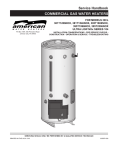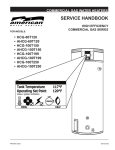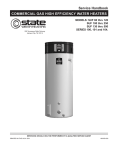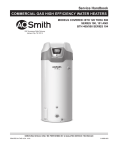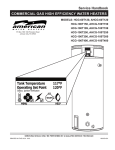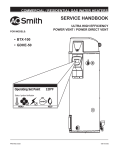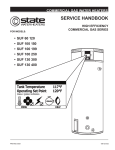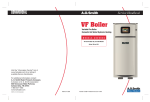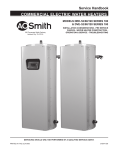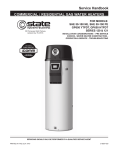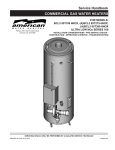Download A.O. Smith BTR 201 Technical information
Transcript
Service Handbook COMMERCIAL GAS WATER HEATERS FOR MODELS: BTN 120 thru 400(A) Series 100 - 108 BTR 151 & 201 Series 100 & 101 500 Tennessee Waltz Parkway Ashland City, TN 37015 INSTALLATION CONSIDERATIONS - PRE SERVICE CHECKS CONSTRUCTION - OPERATION & SERVICE - TROUBLESHOOTING SERVICING SHOULD ONLY BE PERFORMED BY A QUALIFIED SERVICE TECHNICIAN PRINTED IN THE U.S.A. 0713 317923-001 TABLE OF CONTENTS INTRODUCTION . . . . . . . . . . . . . . . . . . . . . . . . . . . . . . . . . . . . . . . . . . . . . . . . . . . . . . . . . . . . . . . . . . . . . . 2 QUALIFICATIONS . . . . . . . . . . . . . . . . . . . . . . . . . . . . . . . . . . . . . . . . . . . . . . . . . . . . . . . . . . . . . . . . . . . . . 2 TOOLS REQUIRED . . . . . . . . . . . . . . . . . . . . . . . . . . . . . . . . . . . . . . . . . . . . . . . . . . . . . . . . . . . . . . . . . . . 3 INSTALLATION CONSIDERATIONS . . . . . . . . . . . . . . . . . . . . . . . . . . . . . . . . . . . . . . . . . . . . . . . . . . . . . . 4 GAS AND ELECTRICAL CHARACTERISTICS . . . . . . . . . . . . . . . . . . . . . . . . . . . . . . . . . . . . . . . . . . . . . . 4 GAS PRESSURE – REQUIREMENTS . . . . . . . . . . . . . . . . . . . . . . . . . . . . . . . . . . . . . . . . . . . . . . . . . . . . . 4 MINIMUM CLEARANCES . . . . . . . . . . . . . . . . . . . . . . . . . . . . . . . . . . . . . . . . . . . . . . . . . . . . . . . . . . . . . . . 8 EXTERIOR CLEARANCES . . . . . . . . . . . . . . . . . . . . . . . . . . . . . . . . . . . . . . . . . . . . . . . . . . . . . . . . . . . . . . 9 GAS VALVE . . . . . . . . . . . . . . . . . . . . . . . . . . . . . . . . . . . . . . . . . . . . . . . . . . . . . . . . . . . . . . . . . . . . . . . . . 10 GAS VALVE . . . . . . . . . . . . . . . . . . . . . . . . . . . . . . . . . . . . . . . . . . . . . . . . . . . . . . . . . . . . . . . . . . . . . . . . . . 11 VENTING TABLES FOR CATEGORY 1 – TYPE B GAS VENT . . . . . . . . . . . . . . . . . . . . . . . . . . . . . . . . . 12 DRAFT PROVING PRESSURE SWITCH – SETTINGS . . . . . . . . . . . . . . . . . . . . . . . . . . . . . . . . . . . . . . . 14 THERMOSTAT AND IGNITION CONTROL BOARD VIEW . . . . . . . . . . . . . . . . . . . . . . . . . . . . . . . . . . . . 15 WHITE RODGERS INTEGRATED CONTROL – THERMOSTAT . . . . . . . . . . . . . . . . . . . . . . . . . . . . . . . . 16 WHITE RODGERS IGNITION CONTROL BOARD . . . . . . . . . . . . . . . . . . . . . . . . . . . . . . . . . . . . . . . . . . 17 GAS CONTROL VALVE/ BURNER AREA VIEW . . . . . . . . . . . . . . . . . . . . . . . . . . . . . . . . . . . . . . . . . . . . . 18 BTN/ BTR 151, 201 – ELECTRICAL SEQUENCE . . . . . . . . . . . . . . . . . . . . . . . . . . . . . . . . . . . . . . . . . . . 19 OPERATING SEQUENCE – FLOW CHART . . . . . . . . . . . . . . . . . . . . . . . . . . . . . . . . . . . . . . . . . . . . . . . . 20 HEATER CONTROL BOARD DIAGNOSTIC LED INTERPRETATION AND TROUBLESHOOTING . . . . . 21 IGNITION CONTROL BOARD DIAGNOSTIC LED INTERPRETATION AND TROUBLESHOOTING . . . . 22 TEST 2 - POLARITY CHECK . . . . . . . . . . . . . . . . . . . . . . . . . . . . . . . . . . . . . . . . . . . . . . . . . . . . . . . . . . . 23 TEST 3 – CONTINUITY CHECK OF HIGH LIMIT (ECO) . . . . . . . . . . . . . . . . . . . . . . . . . . . . . . . . . . . . . . 24 TEST 4 – UPPER TEMPERATURE PROBE CONTINUITY CHECK . . . . . . . . . . . . . . . . . . . . . . . . . . . . . 25 TEST 5 – CALLING FOR HEAT – NO INDUCER OPERATION . . . . . . . . . . . . . . . . . . . . . . . . . . . . . . . . . 26 TEST 6 – INDUCER ON – NO IGNITION . . . . . . . . . . . . . . . . . . . . . . . . . . . . . . . . . . . . . . . . . . . . . . . . . . 27 TEST 7 – INDUCER ON – PROVER SWITCH AND LOW GAS SWITCH CLOSED. NO IGNITER OPERATION . . . . . . . . . . . . . . . . . . . . . . . . . . . . . . . . . . . . . . . . . . . . . . . . . . . . . . . . . . . . . . . . . . . . . . . . 28 TEST 8 – IGNITER HEATS – NO MAIN BURNER . . . . . . . . . . . . . . . . . . . . . . . . . . . . . . . . . . . . . . . . . . . 29 TEST 9 – IGNITER HEATS – NO MAIN BURNER . . . . . . . . . . . . . . . . . . . . . . . . . . . . . . . . . . . . . . . . . . . 30 TEST 10 – MAIN BURNER IGNITION FOR LESS THAN 5 SECONDS . . . . . . . . . . . . . . . . . . . . . . . . . . . 31 TEST 11 – WATER HEATER SHUTTING OFF BELOW SETTING . . . . . . . . . . . . . . . . . . . . . . . . . . . . . . 32 DISPLAY LIGHTS ON INTEGRATED HEATER CONTROL . . . . . . . . . . . . . . . . . . . . . . . . . . . . . . . . . . . . 33 WIRING DIAGRAM . . . . . . . . . . . . . . . . . . . . . . . . . . . . . . . . . . . . . . . . . . . . . . . . . . . . . . . . . . . . . . . . . . . 34 NOTES . . . . . . . . . . . . . . . . . . . . . . . . . . . . . . . . . . . . . . . . . . . . . . . . . . . . . . . . . . . . . . . . . . . . . . . . . . . . 35 NOTES . . . . . . . . . . . . . . . . . . . . . . . . . . . . . . . . . . . . . . . . . . . . . . . . . . . . . . . . . . . . . . . . . . . . . . . . . . . . 36 NOTES . . . . . . . . . . . . . . . . . . . . . . . . . . . . . . . . . . . . . . . . . . . . . . . . . . . . . . . . . . . . . . . . . . . . . . . . . . . . 37 Servicing should only be performed by a Qualified Service Technician 1 INTRODUCTION The service handbook is designed to aid in servicing and troubleshooting A. O. Smith BTN and BTR 151/201 commercial water heaters in the field. No duplication or reproduction of this book may be made without the express written authorization of the A. O. Smith Corporation. The following text and illustrations will provide you with a step by step procedure to verify proper installation, operation, and troubleshooting procedures. Additional quick reference data is included to assist you in servicing these products. The information contained in this handbook is designed to answer commonly faced situations encountered in the operation of this product line and is not meant to be all inclusive. If you are experiencing a problem not covered in this handbook, please contact A. O. Smith Technical Information at 1-800-527-1953, by email at [email protected], or your local A. O. Smith Corporation representative for further assistance. Our website at: http://www.hotwater.com is also a resource for installation and service information. This handbook is intended for use by licensed plumbing professionals and reference should be made to the installation manual accompanying the product. This handbook contains supplemental information to the product’s installation and operation manual. QUALIFICATIONS “Qualified Service Technician" or "Qualified Agency” Installation and service of this water heater requires ability equivalent to that of a Qualified Agency (as defined by ANSI below) in the field involved. Installation skills such as plumbing, air supply, venting, gas supply and electrical supply are required in addition to electrical testing skills when performing service. ANSI Z223.1 Sec. 3.3.85: “Qualified Agency” - “Any individual, firm, corporation or company that either in person or through a representative is engaged in and is responsible for (1) the installation, testing or replacement of gas piping or (2) the connection, installation, testing, repair or servicing of appliances and equipment; that is experienced in such work; that is familiar with all precautions required; and that has complied with all the requirements of the authority having jurisdiction.” Service of this water heater requires ability equivalent to that of a Qualified Service Technician in the field involved. Installation skills such as plumbing, air supply, venting, gas supply, electrical supply are required in addition to electrical testing skills. Some products may require combustion testing equipment and certification. If you do not possess these skills or do not have the proper tools you should not attempt to service this water heater. SERVICE WARNING If you are not qualified (as defined by ANSI above) and licensed or certified as required by the authority having jurisdiction to perform a given task do not attempt to perform any of the procedures described in this manual. If you do not understand the instructions given in this manual do not attempt to perform any procedures outlined in this manual. SERVICE REMINDER When performing any troubleshooting step outlined in this manual always consider the wiring and connectors between components. Perform a close visual inspection of all wiring and connectors to and from a given component before replacement. Ensure wires were stripped before being crimped in a wire connector, ensure wires are crimped tightly in their connectors, ensure connection pins in sockets and plugs are not damaged or worn, ensure plugs and sockets are mating properly and providing good contact. Failure to perform this critical step or failing to perform this step thoroughly often results in needless down time, unnecessary parts replacement, and customer dissatisfaction. 2 Servicing should only be performed by a Qualified Service Technician TOOLS REQUIRED • • Electrical multimeter capable of measuring continuity/ ohms, ac & dc volts, amperes, microamperes, millivolts, and frequency (hz) • UEi Model DL289 or equivalent Digital manometer + 60" W. C., resolution 0.01" increments Note: A digital manometer is required for testing pressure switches and can replace a gas pressure gauge, draft gauge or slack tube manometer for checking gas pressure. • UEi model EM200 or equivalent • Water pressure gauge w/lazy hand and hose bibb connection • Thermometer • 1-1/16 Inch socket with extension for anode replacement • Phillips head screwdriver • Set of numbered drill bits • Standard screwdrivers • 3/8, 7/16, 1/2 and 9/16 inch open end wrench DIGITAL MANOMETER DIGITAL MULTIMETER WATER PRESSURE TEST GAUGE W/LAZY HAND AND HOSE BIBB CONNECTION Servicing should only be performed by a Qualified Service Technician 3 INSTALLATION CONSIDERATIONS GAS AND ELECTRICAL CHARACTERISTICS Models Gas Type All Models Natural Gas Supply Pressure Minimum Maximum 5.2" W.C. (1.29 kPa) 14.0" W.C. (3.48 kPa) Gas Manifold/ Pressure Volts/Hz Amperes 120/60 120/60 <5 All models require a minimum gas supply pressure of 5.2” W.C. The minimum supply pressure is measured while gas is flowing (dynamic pressure). The supply pressure (dynamic) should never fall below 5.2” W.C. The supply pressure should be measured with all gas fired appliances connected to the common main firing at full capacity. If the supply pressure drops more than 1.5” W.C. as gas begins to flow to the water heater then the supply gas system including the gas line and/or the gas regulator may be restricted or undersized. The gas valve on all models has a maximum gas supply pressure limit of 14" W.C. The maximum supply pressure is measured while gas is not flowing (static pressure). GAS PRESSURE – REQUIREMENTS Main line gas pressure to the water heater for natural gas should be between a maximum of 14" W.C. (3.48 kPa) static pressure and a minimum of 5.2" W.C. (1.29 kPa) dynamic pressure for Natural Gas. A supply gas pressure regulator (service regulator) must be installed on the gas supply line no closer than 3 feet (1 meter) and no farther than 8 feet (2.4 meters) of equivalent length from the water heater's inlet connection. 1. Check gas line pressure with a manometer. 2. Cycle the burner on and off several times to check its operation. 3. Check the operation of the limit and operating controls. 4. Check the vent system seams and joints and ensure that there is no discharge of flue products into the room. 5. Check the input rate. Supply gas pressure shall be measured while the water heater is not firing (static pressure) and while the water heater is firing at full capacity (dynamic pressure). If the supply gas pressure to the water heater is not between the required minimum and maximum values given in table above, adjust the supply gas regulator as necessary. Adjust the supply gas regulator(s) per the regulator manufacturer’s instructions to achieve the required “static” and “dynamic” supply gas pressure. MULTIPLE APPLIANCE INSTALLATIONS: In multiple water heater installations or in installations where the installed water heater(s) share a common gas supply main with other gas fired appliances; the supply gas pressures shall be measured at each water heater with all gas fired appliances connected to a common main firing at full capacity. In multiple water heater installations the supply gas line regulators shall be adjusted to provide gas pressure to each water heater within the minimum and maximum supply pressure requirements listed in table above with all gas fired appliances connected to a common gas main firing at full capacity. Note: A pressure drop of more than 1.5” W. C. (0.37 kPa) when the main burner ignites is an indication of an inadequate supply of gas and can lead to ignition failure, rough starts and/or rough operation. If a drop of more than 1.5” W. C. (0.37 kPa) in supply gas pressure occurs when the main burner ignites, ensure the supply gas lines and regulator(s) are properly sized and installed. 4 Servicing should only be performed by a Qualified Service Technician AIR SUPPLY: Stoichiometric or theoretical complete combustion requires 10 cubic feet of air per 1,000 BTU of gas supplied. The National Fuel Gas Code also recommends an additional 2.5 cubic feet of “excess” air. For information on minimum make-up air opening sizes for various building installations, refer to the National Fuel Gas Code NFPA 54/ANSI Z223.1. INSUFFICIENT MAKE-UP AIR, NEGATIVE AIR PRESSURE AND DOWNDRAFTS: Downdraft Caused by Kitchen Vent Hood A lack of combustion and ventilation air can create a negative ambient air pressure in the installed space. The vent system on one or more gas fired appliances can experience down drafts due to the outdoor air pressure being greater than the ambient air pressure in the installed space. Where multiple gas fired appliances are installed, one or more gas fired appliances can “pull air” through the vent system(s) of other appliances installed nearby. One common example is in a restaurant installation where exhaust vent equipment was not considered in sizing make-up requirements. This condition may result in air being back drafted by the restaurant exhaust equipment through the heater causing the draft proving switch to open and/or erratic heater shutdown. • Down drafts can cause flue gases to spill into the installed space. Servicing should only be performed by a Qualified Service Technician 5 MAKE-UP AIR – DIRECT COMMUNICATION WITH OUTDOORS: A fresh supply of make-up air for combustion can be supplied to the water heater through make-up air ducts, which directly communicate with the outdoors. (Not Direct Vent.) Two openings are required: one within 12 inches of the top of the enclosure and one within 12 inches of the bottom of the enclosure. Each opening must have a free area of not less than 1 square inch per 4,000 BTU/Hr of the total input of all appliances within the enclosure. The lower opening primarily provides combustion air. The upper opening provides vent dilution air and acts as a relief opening for flue gases should the vent become obstructed or a downdraft condition occur. Additionally, when the water heater is installed in a confined space and communicating with the outdoor air, one permanent opening, beginning within 12 inches (30 cm) of the top of the enclosure, must be permitted where the equipment has clearances of at least 1 inch (2.5 cm) from the sides and back, and 6 inches (16 cm) from the front of the appliance. The opening must directly communicate with the outdoors and must communicate through a vertical or horizontal duct to the outdoors or spaces (crawl or attic) that freely communicate with the outdoors, and must have a minimum free area of a) 1 square inch per 3,000 BTU/Hr (7cm2 per kW) of the total input of all equipment located in the enclosure and b) not less than the sum of the areas of all vent connectors in the confined space. CONTAMINATED AIR: Corrosion of the flue ways and vent system may occur if air for combustion contains certain chemical vapors. Such corrosion may result in failure and risk of asphyxiation. Combustion air that is contaminated can greatly diminish the life span of the water heater and water heater components such as hot surface igniters and burners. Propellants of aerosol sprays, beauty shop supplies, water softener chemicals and chemicals used in dry cleaning processes that are present in the combustion, ventilation or ambient air can cause such damage. Do not store products of this sort near the water heater. Air which is brought in contact with the water heater should not contain any of these chemicals. If necessary, uncontaminated air should be obtained from remote or outdoor sources. The limited warranty is voided when failure of water heater is due to a corrosive atmosphere. (See limited warranty for complete terms and conditions). 6 Servicing should only be performed by a Qualified Service Technician AIR REQUIREMENTS: For safe operation an adequate supply of fresh uncontaminated air for combustion and ventilation must be provided. An insufficient supply of air can cause recirculation of combustion products resulting in contamination that may be hazardous to life. Such a condition often will result in a yellow, luminous burner flame, causing sooting of the combustion chamber, burners and flue tubes and creates a risk of asphyxiation. Do not install the water heater in a confined space unless an adequate supply of air for combustion and ventilation is brought in to that space using the methods described in the Confined Space section of the Instruction Manual. Never obstruct the flow of ventilation air. If you have any doubts or questions at all, call your gas supplier. Failure to provide the proper amount of combustion air can result in a fire or explosion and cause property damage, serious bodily injury or death. CLOSED WATER SYSTEMS: Water supply systems may, because of code requirements or such conditions as high line pressure, among others, have installed devices such as pressure reducing valves, check valves, and back flow preventers. Devices such as these cause the water system to be a closed system. THERMAL EXPANSION: As water is heated, it expands (thermal expansion). In a closed system the volume of water will grow when it is heated. As the volume of water grows there will be a corresponding increase in water pressure due to thermal expansion. Thermal expansion can cause premature tank failure (leakage). This type of failure is not covered under the limited warranty. Thermal expansion can also cause intermittent Temperature-Pressure Relief Valve operation: water discharged from the valve due to excessive pressure build up. This condition is not covered under the limited warranty. The Temperature-Pressure Relief Valve is not intended for the constant relief of thermal expansion. CONTAMINATED AIR: Corrosion of the flue ways and vent system may occur if air for combustion contains certain chemical vapors. Such corrosion may result in failure and risk of asphyxiation. Combustion air that is contaminated can greatly diminish the life span of the water heater and water heater components such as hot surface igniters and burners. Propellants of aerosol sprays, beauty shop supplies, water softener chemicals and chemicals used in dry cleaning processes that are present in the combustion, ventilation or ambient air can cause such damage. Do not store products of this sort near the water heater. Air which is brought in contact with the water heater should not contain any of these chemicals. If necessary, uncontaminated air should be obtained from remote or outdoor sources. The limited warranty is voided when failure of water heater is due to a corrosive atmosphere. (See limited warranty for complete terms and conditions). POWER SUPPLY: The water heaters covered in this manual require a 120 VAC, 1Ø (single phase), 60Hz, 15 amp power supply and must also be electrically grounded in accordance with local codes or, in the absence of local codes, with the National Electrical Code, ANSI/ NFPA 70 or the Canadian Electrical Code, CSA C22.1. Servicing should only be performed by a Qualified Service Technician 7 MINIMUM CLEARANCES This water heater is approved for installation on combustible flooring in an alcove with minimum clearance from combustion construction as indicated in below Figure and Table. In all installations the minimum combustible clearances from vent piping shall be 6” (15.2 cm). Vent piping passing through a combustible wall or ceiling must be a continuous run (no joints) and retain 6” (15.2 cm) clearance unless an approved reducing thimble is used. A service clearance of 24” (61 cm) should be maintained from serviceable parts, such as Temperaturepressure relief valves, baffles, digital thermostats, cleanout openings or drain valves. The units are approved for installation with side, rear and ceiling clearances as indicated below: MINIMUM CLEARANCES TO COMBUSTIBLE OR NON-COMBUSTIBLE CONSTRUCTION: MODELS "A" RIGHT SIDE "B" LEFT SIDE "C" BACK "D" CEILING BTN - 120 thru 275/A 2" 6" 3" 2" 2" 6" 3" 2" 2" 6" 3" 2" 12" 12" 12" 12" BTN - 310/A and 366/A BTN - 400 BTR 151 & 201 A, B, and C clearances to non-combustibles is “0” inches except for the BTN - 199C which is 2" and the BTN - 310/A which is 3". The 12" ceiling clearance remains unchanged for all models. 8 Servicing should only be performed by a Qualified Service Technician EXTERIOR CLEARANCES The illustration below shows the required clearances for venting units using natural draft venting. The vent must extend at least 3 feet above the highest point where it passes through a roof of a building and at least 2 feet higher than any portion of a building within a horizontal distance of 10 feet (for vents of 12 inches in diameter or less). References: NFPA 54/ANSI Z223.1 may allow reduction to 8 feet with a "listed vent cap". Servicing should only be performed by a Qualified Service Technician 9 GAS VALVE The supply gas pressure is normally measured at the gas valve inlet gas pressure tap, if available, when the gas is flowing. The manifold gas pressure is measured at the manifold pressure tap of the gas valve when the gas is flowing. Gas valves used are 24 volt AC combination-step opening gas valves. They incorporate the main valve and gas pressure regulator into one body. The inlet view of the gas valve shown on the left, shows the Low Gas Pressure Switch, the Supply Gas Inlet, and the Supply Gas Pressure Tap. The top view of the gas valve, shown on the right, shows the Main Gas Regulator, Manifold Pressure Tap, Top Knob, and the Limited Bleed Vent Port. The main gas regulator is found under the silver cap (silver cap for Natural Gas or black cap for Propane) screw. It is factory preset to 3.5 inches W.C. and adjusts gas pressure output from 3.0 to 5 inches water column. Caution: Always test the manifold pressure at the outlet when the gas is flowing. The outlet view of the Gas Valve, shown on the right, shows the Manifold Gas Outlet Connection, the two 24 volt Main Valve (MV) Solenoid connections, and the Manifold Pressure Tap. The two yellow wires from the 12-pin plug on the Ignition Board attach to the MV terminals. 10 Servicing should only be performed by a Qualified Service Technician GAS VALVE All BTN and BTR water heaters are classified by ANSI as Category I (non-condensing, negative pressure venting) appliances. They are approved for type B vent. The draft inducer does not pressurize the exhaust. For larger applications BTN and BTR 151, 201 water heaters can be common vented together, either in a tapered manifold or constant size manifold. Follow the National Fuel Gas Codes requirements for sizing and installation of fan-assisted products. BTN and BTR 151/201 models may be common vented only with other Category I appliances. See the Venting Section in the National Fuel Gas Code. Servicing should only be performed by a Qualified Service Technician 11 VENTING TABLES FOR CATEGORY 1 – TYPE B GAS VENT Multiple Gas Fired Tank-Type Heaters When venting multiple Category 1 tank type heaters using Type B vent pipe, follow the installation tables below which give sizing and data based upon NFPA 54 ANSI Z223.1. MODEL BTN-120 Input: 120,000 Btu/hr Total Vent Height (Feet) Vent Connector Size: 5 inches 6 8 10 20 30 50 100 Rise Vent Connector Diameter (Inches) 120,000 1 Ft. 6 6 5 5 5 5 5 5 120,000 2 Ft. 5 5 5 5 5 5 5 5 120,000 3 Ft. 5 5 5 5 5 5 5 5 Number of Heaters Combined Input (Btu/hr) Manifold and Common Vent Diameters (Inches) 2 240,000 7 7 7 6 6 6 6 6 3 4 360,000 480,000 8 9 8 9 8 9 7 8 7 8 7 7 6 7 6 7 50 100 MODEL BTN-154, BTR-151 Input: 150,000/ 154,000 Btu/hr Total Vent Height (Feet) Vent Connector Size: 6 inches Number of Heaters 6 Input Btu/hr Rise 8 10 15 20 30 Vent Connector Diameter (Inches) 150,000/ 154,000 1 Ft. 6 6 6 6 6 6 6 6 150,000/ 154,000 2 Ft. 6 6 6 6 6 6 6 6 150,000/ 154,000 3 Ft. 6 6 6 6 6 6 6 6 Combined Input (Btu/hr) Manifold and Common Vent Diameters (Inches) 2 300,000/ 308,000 8 8 7 7 7 6 6 6 3 450,000/ 462,000 9 9 9 8 8 7 7 7 4 600,000/ 616,000 12 10 10 9 9 8 8 7 MODEL BTN-180, BTN-199, BTN-199C, BTN-200; BTR-201 Input: 180,000/ 182,000 and 199,000 Btu/hr Total Vent Height (Feet) Vent Connector Size: 6 inches 6 Input Btuh/hr 180,000/ 182,000 199,000 180,000/ 182,000 199,000 180,000/ 182,000 199,000 Number of Heaters 2 3 4 12 15 Input Btu/hr Combined Input (Btu/hr) Rise 1 Ft. 2 Ft. 3 Ft. 8 10 15 20 30 50 100 Vent Connector Diameter (Inches) 7 7 6 6 6 6 6 6 7 7 7 6 6 6 6 6 6 6 6 6 6 6 6 6 7 7 6 6 6 6 6 6 6 6 6 6 6 6 6 6 6 6 6 6 6 6 6 6 Manifold and Common Vent Diameters (Inches) 360,000 8 8 8 7 7 7 6 6 364,000 9 8 8 7 7 7 6 6 398,000 9 8 8 8 7 7 7 6 540,000 10 9 9 9 8 8 7 7 546,000 10 10 9 9 8 8 7 7 597,000 10 10 10 9 9 8 8 7 720,000 12 12 10 10 9 9 8 8 728,000 12 12 12 10 9 9 8 8 796,000 12 12 12 10 10 9 9 8 Servicing should only be performed by a Qualified Service Technician MODEL BTN-250 Input: 250,000 Btu/hr Total Vent Height (Feet) Vent Connector Size: 6 inches 6 8 10 15 20 30 50 100 Input Btuh/hr Rise Vent Connector Diameter (Inches) 250,000 1 Ft. 8 8 7 7 7 6 6 6 250,000 2 Ft. 7 7 7 7 6 6 6 6 250,000 3 Ft. 7 7 7 7 6 6 6 6 Number of Heaters Combined Input (Btu/hr) Manifold and Common Vent Diameters (Inches) 2 500,000 10 9 9 8 8 8 7 7 3 750,000 12 12 12 10 9 9 8 8 4 1,000,000 14 14 14 12 12 10 9 9 50 100 MODEL BTN-275 Input: 275,000 Btu/hr Vent Connector Size: 6 inches Total Vent Height (Feet) 6 8 10 15 20 30 Input Btuh/hr Rise Vent Connector Diameter (Inches) 275,000 1 Ft. 8 8 8 7 7 6 6 6 275,000 2 Ft. 8 8 7 7 7 6 6 6 275,000 3 Ft. 7 7 7 7 7 6 6 6 Number of Heaters Combined Input (Btu/hr) Manifold and Common Vent Diameters (Inches) 2 550,000 10 10 9 9 8 8 7 7 3 825,000 14 12 12 10 10 9 9 8 4 1,100,000 14 14 14 12 12 12 10 9 50 100 MODEL BTN-310 Input: 310,000 Btu/hr Total Vent Height (Feet) Vent Connector Size: 6 inches 6 8 10 15 20 30 Input Btuh/hr Rise Vent Connector Diameter (Inches) 310,000 1 Ft. - 8 8 8 7 7 6 6 310,000 2 Ft. 8 8 8 7 7 7 6 6 310,000 3 Ft. 8 8 8 7 7 7 6 6 Number of Heaters Combined Input (Btu/hr) Manifold and Common Vent Diameters (Inches) 2 620,000 12 10 10 9 9 8 8 7 3 930,000 14 14 12 12 10 10 9 9 4 1,240,000 16 14 14 14 12 12 10 9 MODEL BTN-366, BTN-400 Input: 366,000 and 399,000 Btu/hr Total Vent Height (Feet) Vent Connector Size: 6 inches 6 Input Btuh/hr 366,000 390,000 366,000 390,000 366,000 390,000 Number of Heaters 2 3 4 Combined Input (Btu/hr) Rise 1 Ft. 2 Ft. 3 Ft. 8 10 15 20 30 50 100 Vent Connector Diameter (Inches) - - - 8 8 7 7 6 - - - - 8 7 7 6 - - 8 8 8 7 7 6 - - - 8 8 7 7 6 - 8 8 8 7 7 6 6 - - 8 8 8 7 7 6 Manifold and Common Vent Diameters (Inches) 732,000 12 12 12 10 9 9 8 8 780,000 12 12 12 10 10 9 9 8 1,098,000 14 14 14 12 12 12 10 9 1,170,000 16 14 14 14 12 12 10 9 1,464,000 16 16 16 14 14 12 12 10 1,560,000 16 16 16 14 14 14 12 10 Servicing should only be performed by a Qualified Service Technician 13 DRAFT PROVING PRESSURE SWITCH – SETTINGS DRAFT PROVING PRESSURE SWITCH TABLE Pressure Setting BTN Models BTR Models To Close Switch (Inches W.C.) 120 -2.40" ± 0.07" 154 -2.20" ± 0.07" 180, 250 -1.60" ± 0.07" 199C -3.00" ± 0.10" 199, 200 -1.95" ± 0.07" 275 -2.30" ± 0.07" 310 -2.60" ± 0.10" 366 -2.00" ± 0.07" 400 -1.75" ± 0.07" 151 -2.50" ± 0.10" 201 -2.20" ± 0.07" Note: Pressure Switch Contacts are Normally Open “N.O.” and close on a fall in pressure. 14 Servicing should only be performed by a Qualified Service Technician THERMOSTAT AND IGNITION CONTROL BOARD VIEW Servicing should only be performed by a Qualified Service Technician 15 WHITE RODGERS INTEGRATED CONTROL – THERMOSTAT 16 Servicing should only be performed by a Qualified Service Technician WHITE RODGERS IGNITION CONTROL BOARD Servicing should only be performed by a Qualified Service Technician 17 GAS CONTROL VALVE/ BURNER AREA VIEW 18 Servicing should only be performed by a Qualified Service Technician BTN/ BTR 151, 201 – ELECTRICAL SEQUENCE The following information will describe the Sequence of Operation for this water heater: 1. Switch power on to unit. 2. Thermostat calls for heat. 3. Ignition Control Board performs diagnostic check on system components. 4. On completion of diagnostics check, the Ignition Control Board sends signal to Exhaust Inducer. 5. Exhaust Inducer begins drawing air through the water heater closing the Prover Switch. 6. On completion of Prover Switch engagement, the Ignition Control Board begins the ignition cycle. 7. The Ignition Control Board provides power to the Silicon Nitride Igniter. 8. The Silicon Nitride Igniter heats up for approximately 17 to 20 seconds. 9. At the end of Silicon Nitride Igniter’s warm-up, the Ignition Control Board opens the Gas Valve. 10.From the time the Gas Valve opens, the Ignition Control Board waits 3 seconds and then shuts of power to the Silicon Nitride Igniter. 11.From the time the Silicon Nitride Igniter’s power is shut off, the Ignition Control Board waits 3 more seconds to monitor the Flame Sensor. 12.If the Flame Sensor does not detect a strong enough flame, the Ignition Control Board shuts off the Gas Valve and allows the Exhaust Inducer to purge the unit for 20 seconds. At that time, the Ignition Control Board restarts with step 7. It will try and ignite the main burners 2 more times. If the unit does not light, the Ignition Control Board will wait one hour and then restart at step 3. This cycle will continue until the unit lights or the power is shutoff to the unit. 13.If the Flame Sensor detects a strong flame, the Ignition Control Board will allow the unit to operate until the thermostat is satisfied. 14.Once the unit is satisfied, the Ignition Control Board will shut off the Gas Valve and the unit will be in standby mode until another call for heat is initiated by the thermostat. Servicing should only be performed by a Qualified Service Technician 19 OPERATING SEQUENCE – FLOW CHART 20 Servicing should only be performed by a Qualified Service Technician HEATER CONTROL BOARD DIAGNOSTIC LED INTERPRETATION AND TROUBLESHOOTING TEST 1 - 120 VAC CHECK TO HEATER: • No Green display "Power" LED On. • Plugs are in receptacles. • Supply power breaker is not “open”. • On/Off heater switch is “On”. TEST 1 120 VAC check to water heater ON/OFF switch. Check for 115-125 VAC black wire to ground\ 115 VAC check to E13 Terminal and 2B receptacle. IF......... THEN............ Voltage is not present from on/off switch center black wire to ground Check conditions above. Power is present from center on/off terminal Voltage is not present at E13 to ground Check wiring from switch to break box. Check power from on/off switch to ignition board terminal E13. Check wiring from on/off. Left-outside terminal to E13. Replace on/off switch. Power is present at E13 Check power from E14 to water heater control E2 receptacle. Voltage is not present from water Check wiring from ignition control board E14 to water heater heater control receptacle E2 black to control receptacle E2. ground Replace ignition control board. Power is present at E2 Green LED should be on. Servicing should only be performed by a Qualified Service Technician 21 IGNITION CONTROL BOARD DIAGNOSTIC LED INTERPRETATION AND TROUBLESHOOTING CONDITIONS: • Power On. • Red, heater control “Call for Heat” LED – on. • Red, ignition control board diagnostic LED – Flashing. • Note LED Flash Code before resetting heater. LED Status 1 Flash 2 Flashes 3 Flashes 4 Flashes 5 Flashes 6 Flashes 7 Flashes 8 Flashes Continuous Flash Continuous ON 22 Indication System is in lock out. Draft proving (pressure) switch failed to open within 5 seconds at the end of the last cycle. Draft proving (pressure) switch failed to close within 5 seconds after the inducer was started. The low gas pressure switch (closes at 5.2" ± 0.4" W. C.) may have remained open (Natural Gas only). Open on high temperature limit switch (ECO). Not used. 115-volt supply power connection is indicating reversed polarity. Flame sensor reads a low flame signal for more than 4.25 sec. No ignition sensed. Continuous flame sensed for more than 5 seconds without gas valve being energized. Internal control board failure. Servicing should only be performed by a Qualified Service Technician TEST 2 - POLARITY CHECK CONDITIONS: • No Green display "Power" LED On. • Plugs are in receptacles. • Supply power breaker is not “open”. • On/Off heater switch is “On”. TEST 1 120 VAC check to water heater ON/OFF switch. Check for 115-125 VAC black wire to ground\ 115 VAC check to E13 Terminal and 2B receptacle. IF......... THEN............ Voltage is not present from on/off switch center black wire to ground Check conditions above. Power is present from center on/off terminal Check wiring from switch to break box. Check power from on/off switch to ignition board terminal E13. Servicing should only be performed by a Qualified Service Technician 23 TEST 3 – CONTINUITY CHECK OF HIGH LIMIT (ECO) CONDITIONS: • Power On – No Hot Water. • Red, heater control “Call for Heat” LED – On. • Red ignition control board diagnostic LED – 4 Flashing. • Note LED Flash Code before resetting water heater control. • See Description of diagnostic LED Flashes. • Turn Power Off. TEST 3 Continuity check of ECO (energy cut-out, high limit). Black to Black wires of upper probe. Power is off. IF......... THEN............ Continuity is indicated (ZERO “0.0” Resistance) Continuity is not present (meter reads “0.L”) Water is less than 120° F Opens at 203° F; closes at 193° F. If water is below 193° F, continuity is correct. Replace ECO sensor, if water temperature is below 193° F. 24 Reset status LED should be on. Replace heater control if control will not manually reset. Servicing should only be performed by a Qualified Service Technician TEST 4 – UPPER TEMPERATURE PROBE CONTINUITY CHECK CONDITIONS: • Power On – Water below temperature set point. • Red, water heater control “Reset Status” LED – OFF. • "Call for Heat" LED Off. OHMS RESISTANCE TABLE °F OHMS 70° 120° 140° 180° 11,884 3,759 2,488 1,169 TEST 4 Upper Temperature Probe continuity check. Red wire to red wire – Turn supply power "Off" for this test. IF......... THEN............ Test indicates no continuity. Continuity is indicated. Replace probe. Probe should be okay (also verify Ohms resistance for water temperature). (Reading will be approximate.) Servicing should only be performed by a Qualified Service Technician 25 TEST 5 – CALLING FOR HEAT – NO INDUCER OPERATION CONDITIONS: • Power On – No Hot Water. • Plugs in Receptacles. • Red "Call for Heat" LED-ON. • Inducer "Off". "call for heat" LED indicator "Diagnostic LED indicator" IF......... THEN............ Pin 1 to ground check has no voltage Reset control by interrupting power - note possible reasons for this from flashing LED code. Pin 1 to ground has voltage Pin 3 to ground has no voltage Replace ignition board. Proceed Check wiring harness and plugs. Replace inducer. 26 Servicing should only be performed by a Qualified Service Technician TEST 6 – INDUCER ON – NO IGNITION CONDITIONS: • Power On. • Plugs in Receptacles. • Inducer operating. • No power to Hot Surface Igniter (HSI) Note LED flash code. TEST 6 IF......... 24 VAC Check of Blower Prover/Low Gas Pressure Circuit THEN............ Ignition board receptacles E1, Pin 7 to ground shows no voltage. E1, Pin 7 has 24 Volt to ground Voltage check of each blower switch terminal to ground shows voltage to only 1 terminal. Replace ignition board. Check wire connection to and from inducer. Switch is open - check for proper draft (should also see LED 3 flash code). Check for blocked exhaust. Check that blower outlet exhaust damper is open. Replace blower (draft) proving switch. NATURAL GAS ONLY 24V is present from each switch terminal to ground. Voltage check to each terminal of low gas pressure switch and ground shows only voltage on 1 terminal Voltage is present to each pressure switch terminal and ground Check wiring from blower switch to low gas pressure switch. Switch is open - test for a minimum of 5.2 ± " W.C. Natural Gas or 10.5" Propane, flowing supply gas pressure (should also see 3 Flash LED code). Replace low gas pressure switch. Check wiring from low gas pressure switch to ignition board receptacles E1, Pin 10. Servicing should only be performed by a Qualified Service Technician 27 TEST 7 – INDUCER ON – PROVER SWITCH AND LOW GAS SWITCH CLOSED. NO IGNITER OPERATION CONDITIONS: • Power On. • Plugs in Receptacles. • Inducer ON. • 24V at ignition board E1, Pin 10. • No power to Igniter. TEST 7 Voltage check and continuity check of hot surface igniter circuit Continuity check - Power off- Plug removed from E4 receptacles. Nominal 80 VAC check - Plug in E4- Power "On". THEN............ IF......... Continuity is not indicated between E4 plug pin 2 to 4. Continuity is present. Voltage is not present between E4, Pin 2 to ground. Voltage is present. Voltage is not present between E4, Pin 4 to ground. Voltage is present. 28 Check wiring and connection from E4 plug to HSI receiving plug. Replace HSI Assembly. Resistance should be between 11 and 20 Ohms at a temperature of 77°F. Replace ignition board. Continue. Check wiring and plug connections to HSI. Replace HSI. Note ignition board, Flash code LED. HSI should work. Servicing should only be performed by a Qualified Service Technician TEST 8 – IGNITER HEATS – NO MAIN BURNER TEST 8 IF......... IGNITOR HEATS......NO MAIN BURNER THEN............ Short heat up time of igniter. Check control box grounding. Normal (Approximate 20 seconds) Check for 24V from E1, Pin 12 to ground during 4 second trial. warm up - no ignition. ........Yes - Continue................No - Replace Ignition Board. No voltage present E4, Pin 12 to Replace ignition board. ground. 24 Volt was present from E1, Pin Check that air has been purged from gas circuit. Check that wiring 12 to ground, but no main burner. and connections to gas valve and E1, Pin 9 are correct. Check for 24 VAC at E1, Pin 9 to ground during 4 second trial for ignition. Servicing should only be performed by a Qualified Service Technician 29 TEST 9 – IGNITER HEATS – NO MAIN BURNER CONDITIONS: • Test 8 completed then: • Turn off power. • Disconnect wires from gas valve. TEST 9 IGNITER HEATS – NO MAIN BURNER THEN............ IF......... Meter reads 0 or 1. Meter indicates pilot and main coil have continuity. 30 • Check meter scale setting to read between 550 and 650 Ohms. • Replace Gas Valve. Valve should be okay, still no gas to main burner, then coil may be stuck. Replace Gas Valve. Servicing should only be performed by a Qualified Service Technician TEST 10 – MAIN BURNER IGNITION FOR LESS THAN 5 SECONDS CONDITIONS: • Power On – plug connected. • Main Burner ignites for approximately 5 seconds then goes out. • Tests 8 and 9 completed. • Note flash code on ignition board LED. TEST 10 IF......... No extended main burner ignition. Still no extended main burner ignition. MAIN BURNER IGNITION FOR LESS THAN 5 SECONDS THEN............ Check wiring and plug connections of HSI assembly plug and ignition board receptacles E1, Pin 2. Check that HSI assembly is not cracked or dirty. Check that flame prover will be in main flame. Replace HSI assembly. Replace ignition control board. Servicing should only be performed by a Qualified Service Technician 31 TEST 11 – WATER HEATER SHUTTING OFF BELOW SETTING CONDITIONS: • Main burner ignited. • Stored water is below temperature setting more than 5° F (Tank Average). • Power Off. • Plug disconnected from heater control board receptacle E3 and E4. WATER HEATER SHUTTING OFF BELOW SETTING TEST 11 (Water Temperature Circuit Check - Continuity) THEN............ IF......... Continuity check pin to pin of lower temperature probe shows 1 or 0 (E4) Continuity check red wire pin to red wire pin on upper temperature sensor shows 1 or 0 (E3). All above checks are okay. 32 See Test 4. Check wiring and plug connections to heater control board receptacle E4. Replace lower temperature probe. See Test 4. Check wiring and plug connections to heater control board receptacle. Replace upper temperature probe. Check wiring and plug connections to heater control board receptacle. Replace upper temperature probe. Servicing should only be performed by a Qualified Service Technician DISPLAY LIGHTS ON INTEGRATED HEATER CONTROL LED STATUS INDICATION Calling for heat The ECO (Energy Cut-Out) has opened. ACTION Normal status. No action required. • Check for excessively hot water (203° F or higher). • Check the resistance of the temperature probes and continuity of the high limit (ECO). No power Check the breaker. Tank is at a set temperature ± 2° F. No action required. Tank has cooled below 120° F. Preceded by “ECO Open” indication. • Push the manual reset button. • Check the resistance of the temperature probes and continuity of the high limit (ECO). Servicing should only be performed by a Qualified Service Technician 33 WIRING DIAGRAM 34 Servicing should only be performed by a Qualified Service Technician NOTES Servicing should only be performed by a Qualified Service Technician 35 NOTES 36 Servicing should only be performed by a Qualified Service Technician NOTES Servicing should only be performed by a Qualified Service Technician 37 COMMERCIAL GAS WATER HEATERS Visit the "Information Central" link of www.hotwater.com for a listing of available Service Handbooks. For additional information contact: A. O. Smith Corporation 500 Tennessee Waltz Parkway Ashland City, TN 37015 1-800-527-1953 www.hotwater.com ©2013 A. O. Smith Corporation 38 317293-001








































